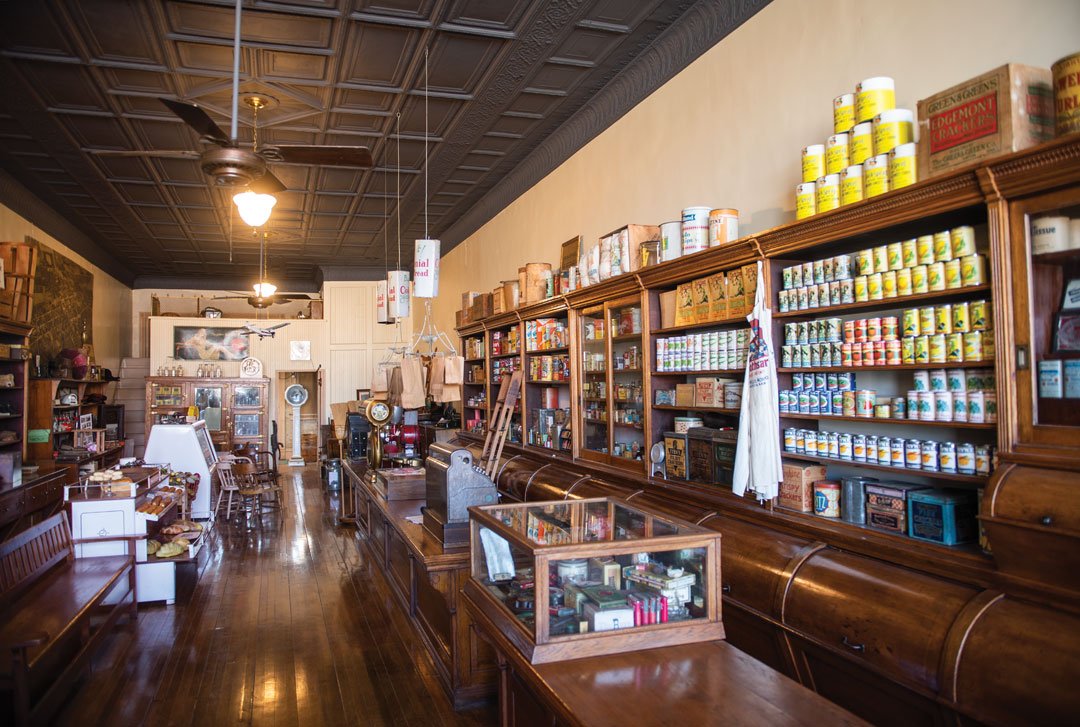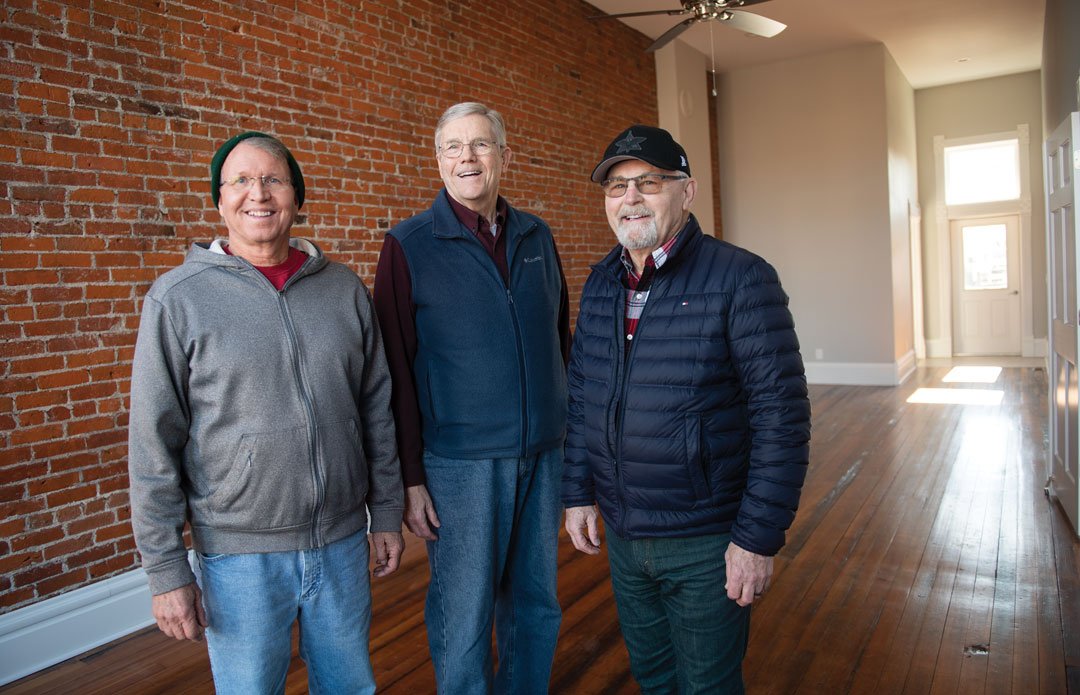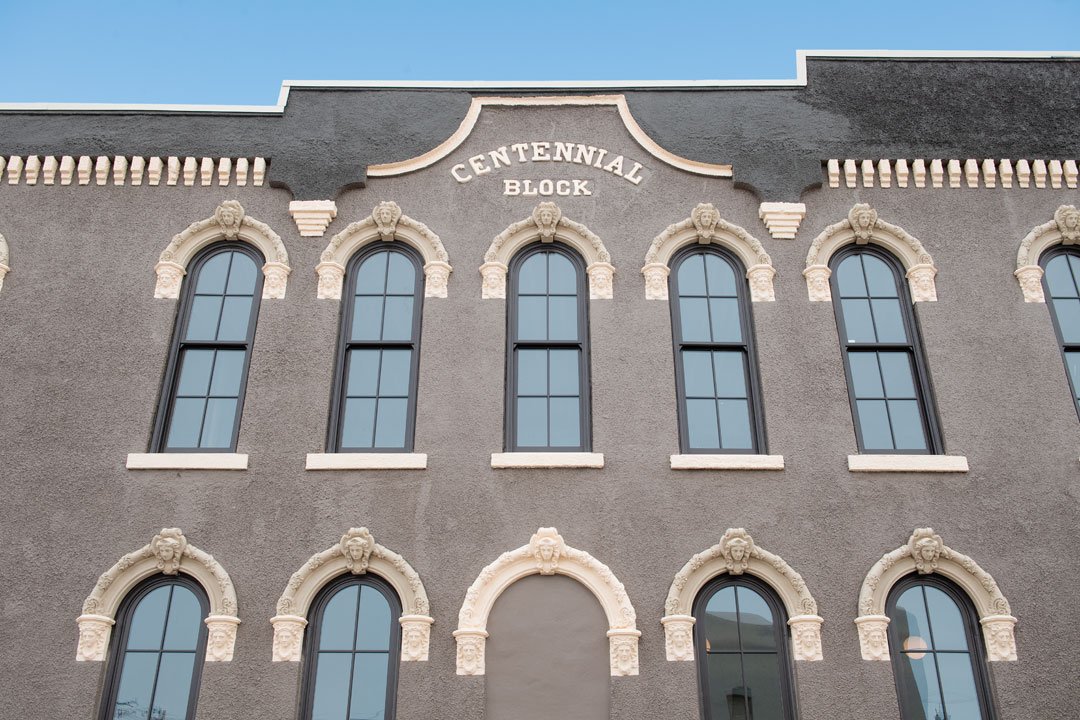Renovations of the historic Varsity Cinema include an expanded concession area, new carpeting and paint. Photo by Duane Tinkey
Creating a sense of place through historic preservations
by kathy a. bolten
The second level includes a lobby that can double as an area for receptions.
Photo by Duane Tinkey
When the Varsity Theater’s longtime owner shuttered the movie house in late 2018, many wondered whether the structure would follow the path of Des Moines’ other single-screen theaters, most of which were razed or deteriorated while sitting unused.
Members of the nonprofit Des Moines Film Society had a different storyline in mind for the Varsity, a place where decades’ worth of memories of first dates and outings with friends and family were created.
In fall 2020, the group purchased the property at 1207 25th St. in Des Moines. The historic theater reopened in December 2022, again providing a place for moviegoers to create memories.
“If we don’t focus on restoring these buildings, we risk losing the heart of who we are as a community, which ties to our identity and our sense of place,” said Michael Wagler, Main Street Iowa’s state coordinator and a Des Moines Film Society member.
The Varsity occupies a two-story structure built in 1917. Occupants have included automobile dealerships, a mess hall and canteen, and a bottling plant for Coca-Cola. But it is the building’s run as a movie house that endeared the place to generations of moviegoers.
The Varsity opened on Christmas Day 1938 and for several decades showed films headlined by the movie industry’s biggest names. The theater became a staple in the Drake neighborhood, a place where hundreds saw their first movie, held the hand of their first love and hung out with friends.
Unable to compete with the multiscreen theaters that began appearing in the late 1970s, the Varsity started showing foreign-made and artistic films. Videotape players and retail stores that rented movies added more competition for the Varsity. So did cable television and its wide assortment of movie channels.
Eighty years after showing its first movie, the Varsity closed. But the closure wasn’t permanent. After a campaign that raised over $840,000 in private donations, work began to restore the structure.
Nearly $5 million in renovations were made to the theater, which has been designated a local landmark. The renovations include an expanded lobby, upgraded concessions with a full bar, and the addition of an elevator and second-level auditorium. A new sound system was installed and new screens added to the auditoriums. The outside of the building, now called the Varsity Cinema, also has been refurbished.
“Many communities, from Des Moines to the smallest in the state, are using historic preservation to create a sense of place and quality of life,” Wagler said. “That’s really nice.”
The auditorium includes new seating, lighting and screen. The auditorium seats 240 people. Photo by Duane Tinkey
What is ‘placemaking?’
The term “placemaking” has been in use since at least the 1960s when those in community development used it as a strategy to improve local places. In 2011, the National Endowment for the Arts expanded the term to “creative placemaking,” describing it as a partnership among public, private, nonprofit and community sectors.
“Creative placemaking animates public and private spaces, rejuvenates structures and streetscapes, improves local business viability and public safety, and brings diverse people together,” the NEA wrote in its white paper.
In short, “placemaking” is creating places where people want to live, work and play. The places can include natural amenities like rivers and forests and human-made amenities like trails and parks. They can also include buildings.
“Everyone thinks creative placemaking is new; it’s not really,” said Deb McGinn, a community leader in Jefferson and a member of the group Why Not Us LLC, which was formed to save a building on the Greene County community’s town square.
“Saving buildings like the Centennial Block building creates a sense of pride and a sense of place, not only about what has happened in the building in the past but what can happen today and in the future,” she said.
A group of women from Jefferson pooled their money to buy the historic Centennial Block building and pay for its restoration. The women, all part of Why Not Us, also found someone to operate a restaurant in the building.
Among the Centennial Building’s distinctive features are the arched terra-cotta hoods over the exterior windows and an interior doorway. Photo by Duane Tinkey
Since the restaurant opened, foot traffic to businesses in Jefferson’s town square has increased, said Matt Wetrich, executive director of Jefferson Matters: A Main Street and Chamber Community. The restaurant, called the Centennial, “is unique and original.”
As restoration plans for the Centennial Block moved forward, other redevelopment near the building began occurring. A business owner purchased and updated a building just west of the Centennial Block. The building, which had housed a pizzeria, is now home to the Stitch, a quilt shop with a classroom and workroom. The Funky Zebra, a clothing boutique, opened in the summer of 2021 in a renovated historical building just north of the Centennial Block.
In addition, the city of Jefferson is providing grants to business owners to refurbish storefronts and make other improvements.
“The things that are happening in Jefferson mean growth for the community,” Wetrich said. “People want to come and see what is happening around the town square. They want to visit the shops … and our bell tower. … All of that are examples of creative placemaking.”
State’s role in historic preservation
The state of Iowa created its Historic Preservation Tax Credit program in 2000 as a way to preserve historic structures and spark economic revitalization in the state’s communities.
In the past five years, nearly $204.5 million in tax credits has been awarded to 175 projects.
In the past three years or so, Wagler said he’s seen interest growing in renovating and reinvesting in historic buildings. In addition, interest has increased in providing housing in the upper levels of historic properties, especially in communities’ business districts.
Providing more housing brings additional traffic to nearby businesses, Wagler said. Thriving businesses attract more business to an area.
“The tie between historic preservation and small business development can’t be overlooked,” Wagler said. “I think we can shine a heavier light on that as a kind of benefit to historic preservation.”
Iowa’s historic tax credit preservation program
In the past five years, the state of Iowa has awarded more than $204.4 million through the Historic Preservation Tax Credit program that was created by lawmakers in 2000.
The program encourages redevelopment and reuse of Iowa’s historic structures, including warehouses, underused or vacant schools, factories, retails stores, hotels, apartments, and other types of buildings.
When it began, the amount of annual awards was capped at $2.4 million, according to an annual report on the program. In the fiscal year that ended June 30, 2013, the cap was raised to $45 million.
Since the fiscal year that began July 1, 2017, 175 projects have been awarded Historic Preservation Tax Credits, according to the Iowa Economic Development Authority. At least 31 projects involved restoration of residential properties and 23 involved mixed-use projects. (Not all of the projects in the list provided by IDEA included a project type.)
The chart below includes the 10 projects awarded the highest amount of tax credits in the past five years. Click here to see the entire list.
| Historical Building Name | Award amount |
Building location (city or county) | Applicant | Fiscal award year | Property type |
| Hotel Fort Des Moines | $13,605,437 | Des Moines | Hawkeye Hotels | 2020 | Hotel/other lodging |
| Warrior Hotel | $12,416,067 | Sioux City | Restoration St. Louis | 2020 | Hotel/other lodging |
| Hippee Building | $9,600,000 | Des Moines | 206 6th Avenue, LLC | 2020 | Hotel/other lodging |
| Carr, Ryder & Adams Co. Bldg. 24 | $8,750,000 | Dubuque | Gronen Development, Inc. | 2020 | Office/commercial |
| Gordon-Van Tine Lofts | $7,590,085 | Scott County | Y & J Properties LLC | 2018 | Residential |
| Roshek Brothers Department Store | $7,550,000 | Dubuque | Gronen Development, Inc. | 2023 | Office/commercial |
| Des Moines Howard Johnson Motor Lodge | $5,099,000 | Des Moines | Christensen Development | 2022 | Hotel/other lodging |
| Warnock/Benson Building | $4,987,870 | Sioux City | HarKay Development LLC | 2022 | Mixed use |
| Burlington, Cedar Rapids and Northern RR Building | $4,505,303 | Cedar Rapids | The Palmer Building, LC | 2023 | Residential (market rate) |
| Badgerow Building | $4,503,466 | Sioux City | Rosin Preservation, LLC | 2022 | Mixed use |
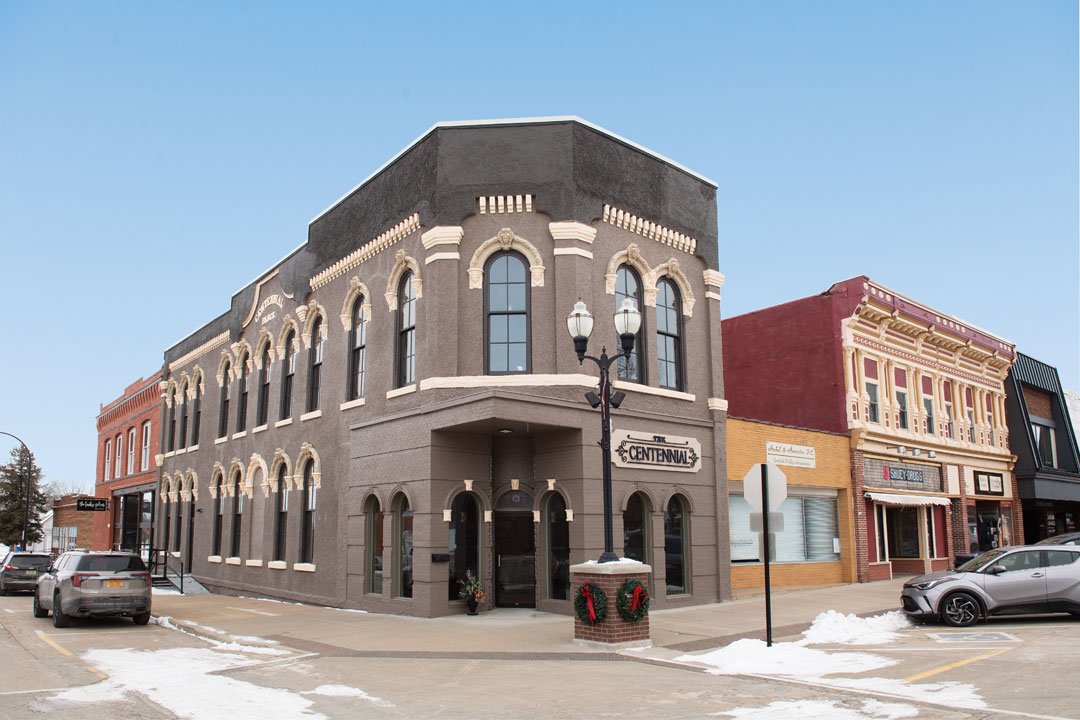
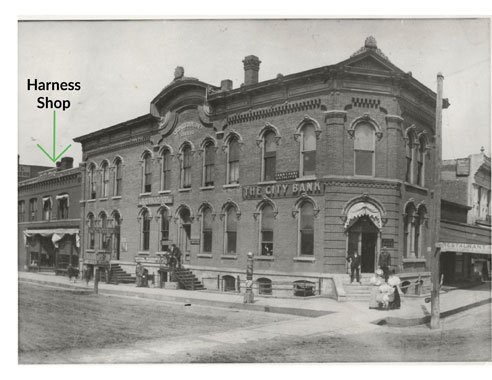

How saving a building re-energized Jefferson’s town square
by kathy a. bolten
JEFFERSON – Tourism in this Greene County community slowed to a trickle within weeks of a burst water pipe that shut down the town’s popular tea room.
The February 2019 breakage poured 44,000 gallons of water into Angie’s Tea Garden, which was housed in the historic Centennial Block building on the northwest corner of Jefferson’s town square.
The physical damage done to the then 143-year-old building was gut-wrenching. So was the other, less visible, damage that also occurred.
“All of our bus tours that summer stopped coming to Jefferson because there wasn’t a nice sit-down restaurant anymore,” said Deb McGinn, a community leader and board member of Why Not Us, a limited liability company formed to save the Centennial Block building. “It was devastating.”
The distinctive-looking building constructed with brick from nearby Grand Junction sat empty for months. The building’s owner decided repairing the water damage was too expensive and sold the property to the city.
“Not many city councils would have done what they did,” McGinn said. “They recognized that we couldn’t lose this building. … Jefferson is one of the last remaining communities in Iowa with an intact town square.”
The commercial area surrounding Jefferson’s town square had been designated a historic district by the National Register of Historic Places in 2011. Not only did having a shuttered building taint the area’s image, it also failed to contribute to the economic vitality of the square.
A group of women, all volunteers in Jefferson, pondered what would become of the building and whether there would ever be another restaurant to attract tourists to the town square. The women decided to buy the building from the city, renovate it and find someone to open a new restaurant.
“The women started talking and came up with the idea that if each woman contributed $5,000, then maybe we could buy the building and fix it up,” said Jacque Andrew, a Why Not Us board member.
The original group of 30 women also decided to tie the fundraising to the ornate hoods that are over each of the building’s exterior arched windows. Women’s faces are on each terra-cotta hood, a common feature of Victorian architecture.
The women raised over $350,000. In July 2021, the city of Jefferson sold the building to Why Not Us through the city’s 10-year forgivable loan program. Why Not Us also received a $75,000 Challenge Grant and other resources from Main Street Iowa.
Structural problems required a new roof to be put on the building. The interior of the first floor was gutted. New electrical wiring, heating and air conditioning, and walls and flooring were installed. The exterior of the building was freshened with new paint.
Window hoods nearly lost
In the late 1960s, a man by the name of Irish Toal operated a paint store in the Centennial Block building. One day, a passerby stopped to admire the terra-cotta window hoods that adorned the building’s exterior. Each window hood includes three faces of women. The passerby asked Toal if he could buy all of the ornate hoods for $100. Toal, thinking the architectural features must be worth something if a stranger wanted them, declined the offer. Bill Plymat, who wrote “The Victorian Architecture of Iowa,” included the window hoods in his book, writing that they were likely the only ones left in western Iowa. Photo by Duane Tinkey
Work is beginning on the building’s second level, which will include two one-bedroom apartment units. Work is expected to be completed by spring 2024.
A new restaurant, the Centennial, operated by Sarah Ostrander, opened in July 2022.
Since the restaurant opened, tourist buses have also begun to return.
“It was like a blight went away,” Ginny Showman said of the renovation of the Centennial Block building and the opening of the restaurant. Showman works at Fudge’s Flowers and Gifts, located east of the renovated building.
“One empty building leads to another empty building that leads to another, and so on,” she said. “Having the Centennial Building renovated has energized the whole downtown.”
Typically, July is a slow month for the flower shop, Showman said. However, last July was among the shop’s busiest months in 2022. Sales have jumped nearly 30% since the reopening of a restaurant on the town square, she said.
“People go to the tower and then to the restaurant,” Showman said. “And when they’re done eating, they stay and shop. It’s all intertwined.”
In 2002, a three-block area of State Center’s Main Street was designated a Historic Commercial District by the National Register of Historic Places. The historic district includes a building that had been occupied by Watson’s Grocery. It’s now a museum. Photo by Duane Tinkey
Restoring Main Street, one building at a time
by kathy a. bolten
STATE CENTER – In the late 1990s, producers of the movie “Rain” scoured Iowa’s rural communities searching for a Main Street in distress.
The producers of the movie that tells a story about murder, sex and redemption found what they were looking for in State Center.
“Ours was the most depressed-looking [Main Street] they could find,” said Craig Pfantz, mayor of the Marshall County community that has about 1,400 residents. “You drive by these buildings every day and you don’t notice how they are going downhill until somebody from out of town comes in and kind of slaps you upside the face with it.”
State Center got its start around 1864, following the construction of a railroad through the area. The town’s main thoroughfare, located parallel to the rail tracks, included a variety of retail businesses including grocery, dry goods, clothing, hardware, and drug and implement stores. Banks were located along the street, as was a barbershop and pool hall.
For decades, the community thrived. However, when retailers like Walmart and others began opening large stores in nearby communities, business owners in small towns like State Center couldn’t compete. Stores were shuttered and century-old buildings were left to decay.
“When they came here to do that movie, a lot of people began to see the writing on the wall,” Pfantz said. “That was the catalyst that got everything going. …
“We saw what was happening in other smaller, rural towns. Their Main Street – the heart of the town – was deteriorating, neglected. We didn’t want that for State Center.”
The unflattering spotlight snapped State Center’s city leaders and residents into action. In 2000, State Center was designated a Main Street Iowa community, one of 50 in the state that have made a commitment to revitalizing previously economically thriving commercial districts. A couple of years later, a three-block area of Main Street was designated a Historic Commercial District by the National Register of Historic Places. The designation allowed renovation projects to receive state tax credits, grants and other funds, Pfantz said.
City leaders and community volunteers gained experience in restoring buildings before a portion of Main Street was named a historic district. A building near the west end of Main Street that had been home to a grocery and dry goods store sat unused between 1979 and 1989. The building’s owner refused to sell the property. After she died in 1989, the property was acquired by the State Center Development Association. The building, built in 1895, was rejuvenated and is now a local landmark and museum.
“There was a grassroots effort to preserve the grocery store,” said Harlan Quick, a City Council member. “The effort was successful and I think that gave everyone some confidence that we could do this.”
About the time State Center became a Main Street Iowa community, the building next to the grocery store museum nearly collapsed. Rather than demolish Main Street’s only stone-faced building, the community restored it.
“Once you start tearing down buildings, it’s like cancer, it spreads,” said Doug Riley, a volunteer with the development association. “Those buildings share walls. You can’t take one down without affecting the building next to it.”
A funeral home now occupies the building, which was constructed in the late 1890s.
Since the early 2000s, nearly $11 million has been invested into the 102 building projects that have been completed along State Center’s Main Street, according to Main Street Iowa.
In addition, the city has repaved Main Street and installed new sidewalks and light poles. In 2006, a grocery store opened on the east end of Main Street. In 2012, City Hall was renovated and an elevator to the second-floor Community Room was installed. In addition, the development association has spent over $2.6 million acquiring properties, making improvements to the structures and then selling them, according to Main Street Iowa.
Among the buildings the group has purchased and restored is what is known locally as Woods Hospital. Built in 1911, the structure housed doctors’ offices and a hospital until 1953. A nursing home was in the building for nearly 20 years and then a preschool and restaurant. The development association acquired the building after it sat empty for several years, according to a historical narrative of the State Center’s Main Street area.
Two professional offices, a hairstylist and a seamstress are now located in the building.
The association’s most recently restored building is at 116-118 W. Main St. The building, constructed around 1895, is a one-story, two-unit brick block structure. After it was built, two shops occupied the building, including a hat shop owned by a female, one of a few businesses operated by a woman in a rural community, according to a historical narrative.
The building is currently for sale.
“We don’t want to hold on to these buildings; we want to sell them,” Riley said.
Several of the buildings that have been improved now have either first-floor or upper-story housing in them. All of the previously renovated buildings are occupied, Pfantz said.
“Most of the businesses are service-oriented,” he said. “We can’t compete with Marshalltown, Ames, Nevada on the retail.”
Pfantz and Riley acknowledge more work is needed in State Center’s business district. Improvements made 10 or more years ago are showing their age, and at least one building still needs to be renovated.
They are certain, though, that if a filmmaker were looking for a distressed Main Street, State Center wouldn’t fit the bill.
“I wouldn’t call our Main Street depressed anymore,” Pfantz said. “Just look at all the cars we have parked along the street.”
